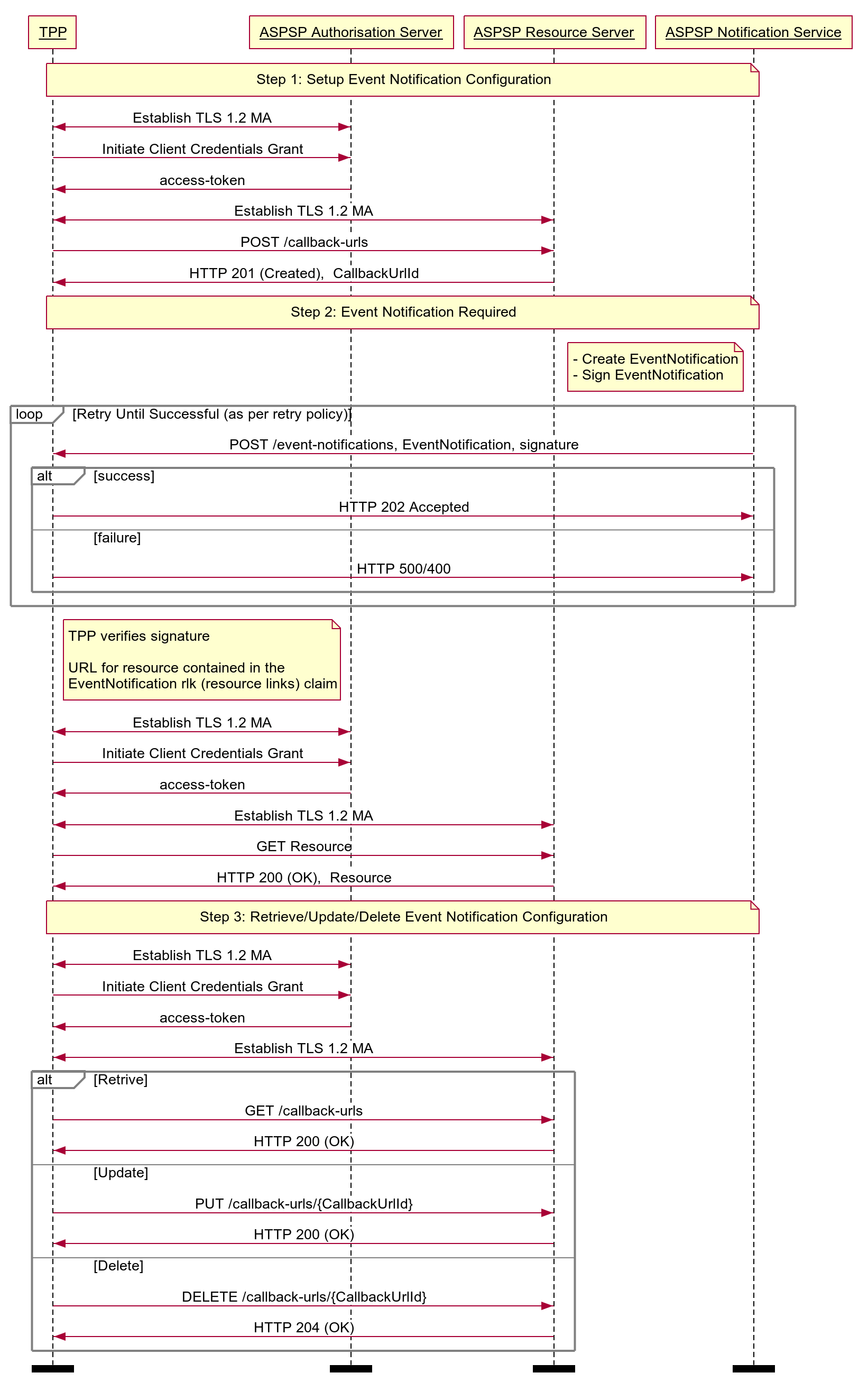Callback URL API Profile - v3.1.2
Overview
The Callback URL API Profile describes the flows and common functionality for the Callback URL API, which allows a TPPs to:
- Register a callback URL with an ASPSP to register to receive a
urn:uk:org:openbanking:events:resource-updateevent notification via the Real Time Event Notification API. - Optionally read, update or delete a registered callback URL.
This profile should be read in conjunction with a compatible Read/Write Data API Profile, a compatible Event Notification API Profile and compatible individual resources.
Basics
Overview
The steps and sequence diagram below provide a general outline of a notification flow for all resources in the R/W APIs.
Steps
Step 1: Setup Event Notification Configuration
- This flow begins with a TPP creating a callback-url resource with an ASPSP.
- The callback URL must be specified at this stage.
Step 2: Event Notification Required
- When an event occurs on a resource that requires a notification, the ASPSP identifies the callback-url associated with the TPP owning the affected resource.
- The ASPSP sends the event notification to the callback URL, detailing the nature of the event and identifying the affected resource.
- The TPP initiates a client credential grant and retrieves the resource using the details contained in the event notification.
Step 3: Retrieve/Update/Delete Event Notification Configuration
- The TPP may optionally read/update/delete the callback-url resource.
Sequence Diagram

Diagram source
``` participant TPP participant ASPSP Authorisation Server participant ASPSP Resource Server participant ASPSP Notification Service note over TPP, ASPSP Notification Service Step 1: Setup Event Notification Configuration end note TPP <-> ASPSP Authorisation Server: Establish TLS 1.2 MA TPP -> ASPSP Authorisation Server: Initiate Client Credentials Grant ASPSP Authorisation Server -> TPP: access-token TPP <-> ASPSP Resource Server: Establish TLS 1.2 MA TPP -> ASPSP Resource Server: POST /callback-urls ASPSP Resource Server -> TPP: HTTP 201 (Created), CallbackUrlId note over TPP, ASPSP Notification Service Step 2: Event Notification Required end note note left of ASPSP Notification Service - Create EventNotification - Sign EventNotification end note loop Retry Until Successful (as per retry policy) ASPSP Notification Service -> TPP: POST /event-notifications, EventNotification, signature alt success TPP -> ASPSP Notification Service: HTTP 202 Accepted else failure TPP -> ASPSP Notification Service: HTTP 500/400 end alt end loop note right of TPP TPP verifies signature URL for resource contained in the EventNotification rlk (resource links) claim end note TPP <-> ASPSP Authorisation Server: Establish TLS 1.2 MA TPP -> ASPSP Authorisation Server: Initiate Client Credentials Grant ASPSP Authorisation Server -> TPP: access-token TPP <-> ASPSP Resource Server: Establish TLS 1.2 MA TPP -> ASPSP Resource Server: GET Resource ASPSP Resource Server -> TPP: HTTP 200 (OK), Resource note over TPP, ASPSP Notification Service Step 3: Retrieve/Update/Delete Event Notification Configuration end note TPP <-> ASPSP Authorisation Server: Establish TLS 1.2 MA TPP -> ASPSP Authorisation Server: Initiate Client Credentials Grant ASPSP Authorisation Server -> TPP: access-token TPP <-> ASPSP Resource Server: Establish TLS 1.2 MA alt Retrive TPP -> ASPSP Resource Server: GET /callback-urls ASPSP Resource Server -> TPP: HTTP 200 (OK) else Update TPP -> ASPSP Resource Server: PUT /callback-urls/{CallbackUrlId} ASPSP Resource Server -> TPP: HTTP 200 (OK) else Delete TPP -> ASPSP Resource Server: DELETE /callback-urls/{CallbackUrlId} ASPSP Resource Server -> TPP: HTTP 204 (OK) end alt option footer=bar ```Callback URL
TPPs must register a URL for TPP hosted services to receive event notifications from an ASPSP. The URL must end with the Event Notification API specification version number, followed by ‘/event-notifications’.
For example:
- URL: https://tpp.com/open-banking/v3.1/event-notifications
Release Management
This section overviews the release management and versioning strategy for the Callback URL API.
Callback-URL Resource
TPPs must register for event-notification callbacks with the version of Event Notification API they have implemented. The version element of the Callback-URL resource is used for this purpose.
POST
- A TPP must only create a callback-url on one version
GET
- A TPP must not access a callback-url on an older version, via the CallbackUrlId for a callback-url created in a newer version.
- E.g., a callback-url created in v4, accessed via v3.
- An ASPSP must allow a callback-url resource to be accessed in a newer version.
- An ASPSP must ensure callback-url fields are unchanged when accessed in a different version.
PUT
- A TPP must not update a callback-url on an older version via a CallbackUrlId created in a newer version.
- E.g., A callback-url is created in v4, and a PUT request on v3.
- An ASPSP must support updating a callback-url from a previous version via a CallbackUrlId created in a newer version.
- E.g., A callback-url is created in v3, and a PUT request on v4.
DELETE
- A TPP must not delete a callback-url on an older version via a CallbackUrlId created in a newer version.
- E.g. A callback-url is created in v4, and request DELETE on v3.
- An ASPSP must support deleting a callback-url from a previous version via a CallbackUrlId created in a newer version.
- E.g., A callback-url is created in v3, and request DELETE on v4.
Callback-URL per TPP
An ASPSP will maintain at most, a single Callback-URL resource per TPP.